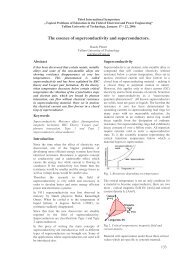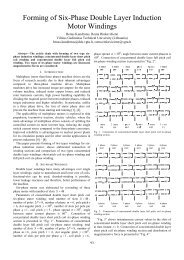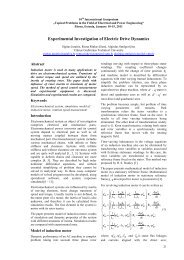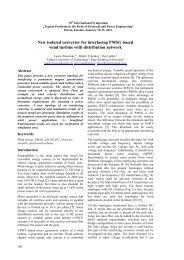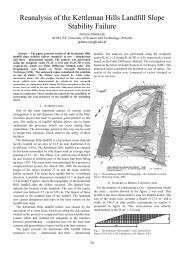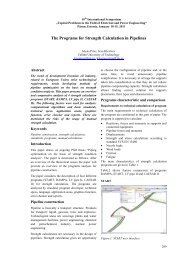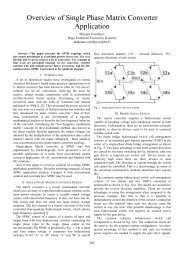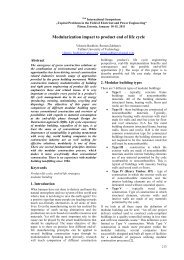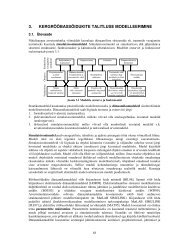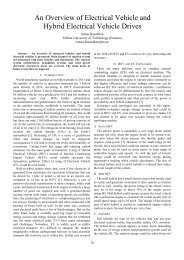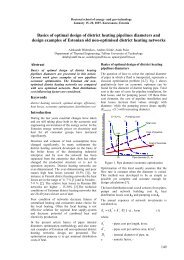Open Source Solutions in High School Mechatronics
Open Source Solutions in High School Mechatronics
Open Source Solutions in High School Mechatronics
- No tags were found...
Create successful ePaper yourself
Turn your PDF publications into a flip-book with our unique Google optimized e-Paper software.
<strong>Open</strong> <strong>Source</strong> <strong>Solutions</strong> <strong>in</strong> <strong>High</strong> <strong>School</strong> <strong>Mechatronics</strong>Dmitry KupriyanovSa<strong>in</strong>t Petersburg National Research University of Informational Technology, Mechanics and Optics (Russia)qudmv@yandex.ruAbstract— This article describes advantages of us<strong>in</strong>g opensourcetechnologies <strong>in</strong> keep<strong>in</strong>g educational process up-to-date. Itconta<strong>in</strong>s an example of educational course, designed to beimplemented on the 1-year students of Mechatronic departmentof NRU ITMO. This course is based around Ardu<strong>in</strong>o opensourcehardware. Us<strong>in</strong>g cheap and up-to-date technical solutionsmotivates students to go deeper <strong>in</strong> their specialty and createprojects at home. Great amount of different articles, projectsand approaches generated by worldwide community helpsstudents to f<strong>in</strong>d way of learn<strong>in</strong>g more suitable for them.Expla<strong>in</strong><strong>in</strong>g the basics and help<strong>in</strong>g with advice becomes theprimary task of the tutor. Rapid development of open-sourcetechnologies and their low price makes educational process moreflexible and allows <strong>in</strong>tegration of new solutions right on the way.<strong>Open</strong>-source license gives no restrictions <strong>in</strong> sell<strong>in</strong>g devices basedon the technology expla<strong>in</strong>ed dur<strong>in</strong>g course, this gives students anopportunity to earn money sell<strong>in</strong>g their project works, whileproprietary educational kits forbid us<strong>in</strong>g their equipment forcommercial purposes.I. INTRODUCTIONIt is common knowledge that mechatronics is a rapidlydevelop<strong>in</strong>g field of eng<strong>in</strong>eer<strong>in</strong>g. This fact makes it critical toteach students us<strong>in</strong>g up-to-date and powerful hardware.Educational courses are usually lagg<strong>in</strong>g beh<strong>in</strong>d life and whenwe talk about rapidly develop<strong>in</strong>g field of science, thisbackwardness can be fatal. And, as we are talk<strong>in</strong>g aboutapplicable science, no one is <strong>in</strong>terested <strong>in</strong> produc<strong>in</strong>gspecialists, who are well tra<strong>in</strong>ed to work with outdatedtechnical solutions. So nowadays the ma<strong>in</strong> goal ofmechatronic methodologist is not only to create an up-to-dateeducational course, but to develop a positive approach, whichwill make educational program more flexible and, as a result,actual.Fig. 1. <strong>Mechatronics</strong> as unity of science fields, the best way to show thenumber of subjects, which must be covered by the program.<strong>Open</strong>-source solutions can lend a help<strong>in</strong>g hand <strong>in</strong> thissituation. They have several advantages over proprietaryeducational kits. They are cheaper, they have larger supportcommunities, their licens<strong>in</strong>g makes it possible to create enduserproduct and modify them, when it is necessary.II. GENERAL OVERVIEWLet’s go through these po<strong>in</strong>ts. Price is a serious issue forthe university, as each kit’s price is multiplied by the numberof workplaces you need to equip.The size of community is critical if we want our course tobe flexible enough. It is impossible to <strong>in</strong>clude all thequestions <strong>in</strong> the educational program due to time issues.Motivated students will be able to f<strong>in</strong>d answers to theirquestions, th<strong>in</strong>k about new projects and, maybe, discovertheir own area of <strong>in</strong>terest <strong>in</strong> mechatronics us<strong>in</strong>g communitysupport, tutors will only have to listen to the <strong>in</strong>terests of theirstudents and adapt the course to the current needs by us<strong>in</strong>gand, what is more important, modify<strong>in</strong>g community materials.Motivation is a key to success. If it will be clear to eachstudent <strong>in</strong>volved <strong>in</strong> educational process that he can <strong>in</strong>fluencerange of topics, learn<strong>in</strong>g rate and other issues, he will takethis responsibility, which will result <strong>in</strong> a more serious attitudeto the subject.It may look like there is no need <strong>in</strong> creation of specialeducational course, as there are dozens of projects andsupportive materials, provided by community, but that’s notthat simple. If we talk about 1- or 2-year students weexperience certa<strong>in</strong> problems with their skills. As there are nosubjects somehow connected to mechatronics <strong>in</strong> schoolprogram, students have drastic differences <strong>in</strong> their tra<strong>in</strong><strong>in</strong>glevel. This makes it necessary to equalize their skills first.Here is where we need basic set of tasks and theoreticalmaterial, but it also need to be balanced enough, so the skilledstudents won’t be just wast<strong>in</strong>g their time. This is a specialtask for each particular country, so methodologist will have alot of work if we keep <strong>in</strong> m<strong>in</strong>d, that quality of school-leaverschanges from year to year and is different <strong>in</strong> differentcountries.What about licens<strong>in</strong>g? It may seem that possibility ofmodification, reproduction [1] and sell<strong>in</strong>g end-user productbased on the <strong>in</strong>itial technology are not so necessary <strong>in</strong>educational process, but let’s th<strong>in</strong>k about it. Modification andreproduction are the key conditions of flexibility. You neverknow what can happen, but it will be disappo<strong>in</strong>t<strong>in</strong>g to writeoff the equipment, which can be adapted to actual needs, butit is prohibited by the license agreement. Possibility to createend-user products can also be a weighty argument, as studentswill be even more motivated, they’ll understand, that they canmake money with the exact technology, they are be<strong>in</strong>g taught.317
III. OPEN SOURCE FOR BEGINNERSAn experimental group was formed <strong>in</strong> an attempt to createsuch educational course for 1-year students. It consists onlyof volunteers, who are will<strong>in</strong>g to discover someth<strong>in</strong>g new andcreate their projects far from narrow frames of speciallydesigned kits. Ardu<strong>in</strong>o was selected as the core of the newmechatronic course. It has all the benefits, described above,but of course there are some limitations, which are not criticalfor the beg<strong>in</strong>ner course. Microcontroller is programmed us<strong>in</strong>gArdu<strong>in</strong>o IDE [2] – open source <strong>in</strong>tegrated developmentenvironment. Schemes and circuits are drawn us<strong>in</strong>g opensource Fritz<strong>in</strong>g editor.Ardu<strong>in</strong>o microcontrollers are basicaly programmed withArdu<strong>in</strong>o programm<strong>in</strong>g language, which is noth<strong>in</strong>g more thanProcess<strong>in</strong>g/Wir<strong>in</strong>g – a C++ dialect [3]. So the programm<strong>in</strong>gskills, ga<strong>in</strong>ed dur<strong>in</strong>g the course won't be useless later, on ahigher levels.As the skills of different students are different, some ofthe learners experience problems even with the pr<strong>in</strong>ciples ofnon-solder<strong>in</strong>g breadboard. Fritz<strong>in</strong>g[2] editor is really helpfulhere, as it can transform the visual appearance of thebreadboard <strong>in</strong>to pr<strong>in</strong>cipal electric scheme. This feature givesan opportunity for students, who are not familiar withpr<strong>in</strong>cipal schemes to catch up with their more skilledcolleagues. This makes it possible to make educationalprocess clear for students of all skill levels.was needed, work with it''s specification and write a program,us<strong>in</strong>g examples from community web-sites.Also, while develop<strong>in</strong>g mechatronic projects, we shouldn'tforget about GUI. At the moment GUI is written us<strong>in</strong>g VisualBasic, but due to platform limitations it will be replacedeither by Python, or by Qt.Students like this approach and show good results. Theyare motivated to browse community resources on their ownand pick new ideas there. If they f<strong>in</strong>d someth<strong>in</strong>g difficult tounderstand, they ask the tutor and receive qualifiedexplanation. All these questions are also recorded <strong>in</strong> order toform theoretical part of the course.IV. FUTURE DEVELOPMENTBy this time project is 30% ready. There are still a lot oflessons to carry. But current situation makes the future of theproject look optimistic. If it will work out the expected way,we will have a good <strong>in</strong>troductory course designed for studentsby students which will <strong>in</strong>clude all necessary equipment,theoretical and practical parts <strong>in</strong>separably connected together.Moreover we will have an approach, which will make us ableto create courses for higher levels.Fig. 2. Visual and pr<strong>in</strong>cipal appearance of electric scheme <strong>in</strong> Fritz<strong>in</strong>g editor.Each lesson students discuss different problems whichoccur on their way, while they are develop<strong>in</strong>g their ownideas. Each lesson some small devices are created, which helpstudents to ga<strong>in</strong> experience <strong>in</strong> design<strong>in</strong>g circuits andunderstand new syntax constructions. Each theoretical pieceof <strong>in</strong>formation is impr<strong>in</strong>ted <strong>in</strong> their memory by apply<strong>in</strong>g it onpractice. By the end of each lesson a number of newquestions is accumulated, these questions will be the topic ofthe next lesson. All these questions, sketches and schemes arerecorded and will be transformed <strong>in</strong>to a workbook by the endof the experiment. Also list of necessary equipment is be<strong>in</strong>gcreated.For example, dur<strong>in</strong>g creat<strong>in</strong>g a large LED array, studentsfaced problem of limited number of outputs. They wereimmediately <strong>in</strong>troduced to shifters. While the pr<strong>in</strong>ciples of theshifter were expla<strong>in</strong>ed, students also found out some<strong>in</strong>formation about electronic device packages, theirdifferences, mount<strong>in</strong>g and purposes. Accord<strong>in</strong>g to this<strong>in</strong>formation, they were able to choose the exact shifter thatFig. 3. Students work<strong>in</strong>g together on the project.Talk<strong>in</strong>g about limitations, there is a prejudice aga<strong>in</strong>stArdu<strong>in</strong>o controllers. Some specialists th<strong>in</strong>k that theirsimplicity makes their use <strong>in</strong> <strong>High</strong> <strong>School</strong> <strong>in</strong>appropriate. Thecase described above is a particular case. Some simplicity isnecessary here. Moreover, the change of programm<strong>in</strong>glanguage is also possible here. But if we talk about higherlevels, there are enough open source projects that can be<strong>in</strong>terest<strong>in</strong>g for our purposes. For example Robot Operat<strong>in</strong>gSystem, distributed and developed under BSD license. Butthis is a topic for another discussion.[1] http://gnu.org[2] http://ardu<strong>in</strong>o.cc[3] http://fritz<strong>in</strong>g.orgREFERENCES318



